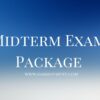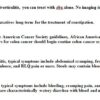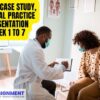Description
NR 511 Final Exam Part 2 (100/100 Points)
- Acute angle-closure glaucoma involves a sudden severe rise in intraocular pressure. Which of the following ranges represents normal intraocular pressure?
- A 28-year-old patient is seen with complaints of diarrhea. Which of the following questions would help the clinician establish the diagnosis of irritable bowel syndrome?
- The presence of hairy leukoplakia in a person with no other symptoms of immune suppression is strongly suggestive of which type of infection?
- Gary is a 55-year-old woman who presents with tightness, pain and limited movement in her right shoulder. She denies any history of trauma. Her exam reveals a 75% reduction in both active and passive range of motion of the right shoulder. Mrs. Gray is also experiencing tenderness with motion and pain at the deltoid insertion. Her medical history is significant for type 1 DMm and HTN. Her social history reveals that she is a secretary ant that she is right-handed. Based on her exam and medical history, you suspect adhesive capsulitis or “frozen shoulder” Which clue in Mrs. Grays history supports the diagnosis?
- A 63-year-old man is seen in the clinic with a chief complaint of nocturia. Which of the following should be included in the differential diagnosis?
- Joyce is seen in the clinic complaining of vague symptoms of feeling nervous and irritable, and that her hair will not hold a curl anymore. On physical exam, the clinician finds an irregular heartbeat and brisk reflexes. The differential diagnosis could be which of the following?
- As diabetic retinopathy progresses, the presence of “cotton wool” spots can be detected. Cotton wool spots refer to:
- Which of the following instructions should be given to a patient with nephrolithiasis?
- Joyce is taking a long-acting beta-agonist for her moderate persistent asthma. What additional medication should she be taking?
- You have detected the presence of crepitus on examination of a patient with a musculoskeletal complaint. Additionally, there is limited range of motion (ROM) with both active and passive movement. These findings suggest that the origin of the musculoskeletal complaint is:
- Harvey has a rubbery, smooth, round mass on his chest which is compressible and has a soft to very firm texture. What do you diagnose this as?
- The patient with Gastroesophageal reflux disease (GERD) should be instructed to eliminate which of these activities?
- If someone responded to antibiotic therapy. Which of the following actions should be taken next?
- Cydney was just diagnosed with mild, intermittent asthma. Which if the most appropriate medication for her?
- A patient is seen in the clinic with hematuria confirmed on microscopic examination. The clinician should inquire about the ingestion of which of these substances that may cause hematuria
- What is the most common cause of anemia?
- The clinical suspects that a client has patellar instability. In order to test for this, the client is seated with the quadriceps relaxed and the knee is placed in extension. Next the patella is displaced laterally and the knee flexed to 30 degrees. IF instability is present, this maneuver displaces the patella to an abnormal position on the lateral femoral condyle, and the client will perceive pain. Testing for patellar instability in this way is known as:
- If your preceptor is out ill on a day that you are scheduled to be in the clinical setting, another preceptor can supervise you as long as they are willing to take you on as a student and they meet the minimum preceptor qualifications.
- Which of the following should be considered in a patient presenting with erectile dysfunction?
- A 23-year-old sexually active man is seen in the clinic with unilateral painful testicular swelling and diagnosed with epididymitis. In order to prescribe the correct drub, the clinician understands that which of these is the most common causative organism?
- The most common offending agents for medication induces resting tremor are:
- Which of the following type of tremor is characterized by an increase in amplitude when the patient attempts voluntary movements?
- Ian, age 62, presents with a wide, diffuse area of erythematous skin on his left lower leg that is warm and tender to palpation. There is some edema involved. You suspect:
- Parkinson’s disease is a progressive neurological disorder that is associated with which type of tremor?
- Which information should be included when you are teaching your patient about the use of nicotine gum?
- Severe pain associated with acute otitis media signifies perforation of the tympanic membrane.
- Jason, aged 62, has obstructive sleep apnea. What do you think is one of his contributing factors?
- The “B” in the ABCDEs of assessing skin cancer represents:
- The patient is diagnosed with urge incontinence. Before prescribing Detrol XL, the provider should question the patient about which of these contraindications to this medication?
- A patient is diagnosed with hypothyroidism. Which of the following electrocardiogram (ECG) changes should the clinician expect as a manifestation of the disease?
- Tori is on systematic antifungals for a bad tinena infection. You understand that serum labs should be monitored for:
- Which of the following signs or symptoms indicate an inflammatory etiology to musculoskeletal pain?
- A 22-year-old is seen complaining of vague belly pain. This type of pain is seen at what point in appendicitis?
- A patient presents to the clinician’s office with a sore throat, fever of 100.7 and tender anterior cervical lymphadenopathy. The clinician suspects strep throat and performs a rapid strep test that is negative. What would the next step be?
- Which of the following statements is true regarding the treatment of carpel tunnel syndrome?
- Which statement about HIV post-exposure prophylaxis (PEP) for healthcare workers is most accurate?
- Sinusitis is considered when there are episodes of prolonged inflammation with repeated or inadequately treated acute infection lasting greater then:
- A patient presents with the following signs and symptoms: gradual onset of low-grade fever, marked fatigue, severe sore throat and posterior cervical lymphadenopathy. Based on the signs and symptoms alone, which of the following conditions is most likely the cause?
- In which of the following situations would refer to a specialist be needed for sinusitis
- Heart valve damage resulting from acute rheumatic fever is a long-term sequela resulting from infection with which of the following pathogens?
- What is the recommended calcium intake for adults over the age of 50 with low bone mass?
- A 14-year-old is seen with complaints of severe testicular pain. The clinician suspects testicular torsion. Which of the following is the appropriate action?
- All students are subject to review of clinical logs to ensure that they have received a well-rounded experience
- A 30-year-old patient presents with pain on urination. The urine microscopy of unspun urine showed greater than 10 leukocytes/ml and a dipstick was possible for nitrates. What is the probable diagnosis?
- Fluctuations and reductions in estrogen may be a contributing factor in which type of rhinitis?
- John is a 16-year-old boy who presents to the emergency room after hurting his knee in a football game. He described twisting his knee and then being unable to extend it completely. John tells the clinician that he heard a pop when the injury occurred and has been experiencing localized pain. The clinician suspects a meniscal tear. Which test would be most appropriate to assess for the presence of a meniscal tear?
- Your patient has decided to give Chantix a try to quit smoking. You are discussing his quit date, and he will begin taking the medication starting tomorrow. When should he plan to quit smoking?
- The patient is prescribed radioactive iodine (RAI) and asks the clinician how this drug works. The clinician’s response should include which of the following data?
- Samuel, age 5, is receiving radiation therapy for his acute lymphocytic leukemia. He is at increased risk of developing which type of cancer as a secondary malignancy when he becomes an adult?
- Why is parathyroid hormone secretion increased during pregnancy?






